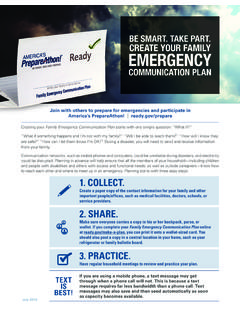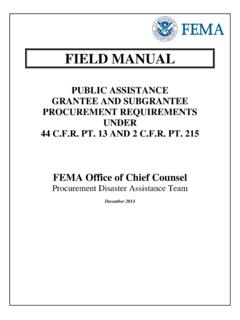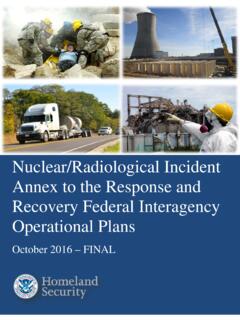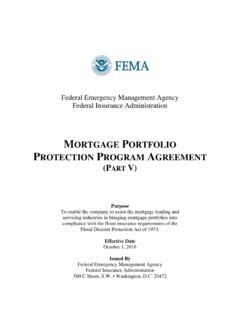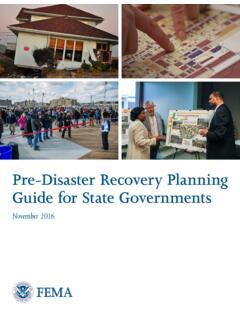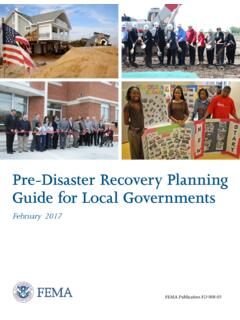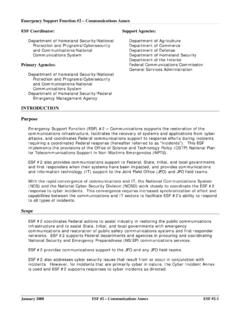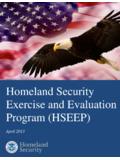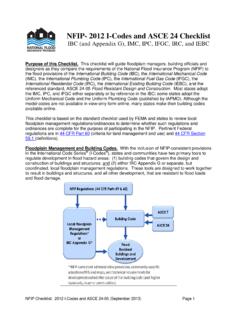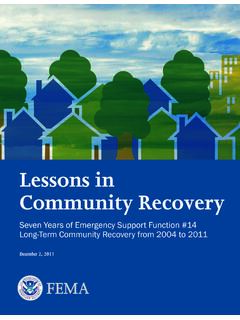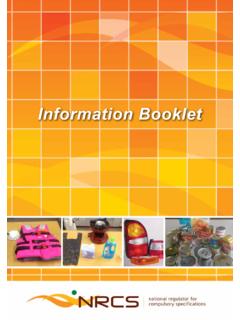Transcription of NATIONAL INCIDENT MANAGEMENT SYSTEM - …
1 NATIONAL INCIDENT MANAGEMENT SYSTEM Training Program September 2011 September 2011 ii NIMS Training Program ENT MANAGEMENT SYSTEM Training Program September 2011 This page intentionally left blank. September 2011 iii NIMS Training Program CONTENTS PREFACE ..vi INTRODUCTION AND OVERVIEW.
2 1 INTRODUCTION .. 1 AUDIENCE .. 3 PURPOSE .. 3 ADULT LEARNING IN EMERGENCY MANAGEMENT .. 4 NIMS TRAINING PROGRAM ORGANIZATION .. 5 CURRENT STATE OF NIMS TRAINING PROGRAM .. 7 OPERATIONAL NEEDS DEFINE CORE COMPETENCIES .. 8 COORDINATING NIMS TRAINING RESPONSIBILITIES .. 8 NIMS CORE CURRICULUM ..11 NIMS TRAINING ELEMENTS ..21 PERSONNEL QUALIFICATION ..22 REFERENCES ..23 APPENDIX A: FEDERAL TRAINING WEB RESOURCES ..27 APPENDIX B: NIMS CORE CURRICULUM COURSE SUMMARIES ..29 ICS-100: Introduction to the INCIDENT Command ICS-200: ICS for Single Resources and Initial Action Incidents ..32 ICS-300: Intermediate ICS for Expanding Incidents.
3 33 ICS-400: Advanced ICS ..35 IS-700: NATIONAL INCIDENT MANAGEMENT SYSTEM , An Introduction ..36 IS-701: NIMS Multiagency Coordination SYSTEM (MACS) ..37 IS-702: NIMS Publication Information Systems ..38 IS-703: NIMS Resource MANAGEMENT ..39 IS-704: NIMS Communication and Information MANAGEMENT ..40 IS-706: NIMS Intrastate Mutual Aid An Introduction ..41 IS-800: NATIONAL Response Framework, An Introduction ..42 E/L 950: All-Hazards Position Specific INCIDENT Commander ..43 E/L 952: All-Hazards Position Specific Public Information Officer ..44 E/L 954: All-Hazards Position Specific Safety Officer.
4 45 E/L 956: All-Hazards Position Specific Liaison Officer ..46 E/L 958: All-Hazards Position Specific Operations Section E/L 960: All-Hazards Position Specific Division/Group Supervisor ..48 E/L 962: All-Hazards Position Specific Planning Section Chief ..49 E/L 964: All-Hazards Position Specific Situation Unit Leader ..50 September 2011 iv NIMS Training Program E/L 965: All-Hazards Position Specific Resources Unit Leader ..51 E/L 967: All-Hazards Position Specific Logistics Section Chief.
5 52 E/L 969: All-Hazards Position Specific Communications Unit Leader ..53 E/L 970: All-Hazards Position Specific Supply Unit Leader ..54 E/L 971: All-Hazards Position Specific Facilities Unit Leader ..55 E/L 973: All-Hazards Position Specific Finance/Admin. Section Chief ..56 E/L 975: All-Hazards Position Specific Finance/Admin. Unit Leader Course ..57 G-191: INCIDENT Command SYSTEM / Emergency Operations Center Interface ..58 G-775: Emergency Operations Center (EOC) MANAGEMENT and Operations ..59 APPENDIX C: FEMA-SPONSORED, NIMS SORTED ALPHABETICALLY ..61 SORTED BY COURSE CODE ..69 September 2011 v NIMS Training Program This page intentionally left blank.
6 September 2011 vi NIMS Training Program PREFACE On March 1, 2004, the Department of Homeland Security (DHS) published the first NATIONAL INCIDENT MANAGEMENT SYSTEM (NIMS). NIMS provides a consistent template enabling Federal, State, tribal, and local governments, the private sector, and nongovernmental organizations to work together to prepare for, prevent, respond to, recover from, and mitigate the effects of incidents regardless of cause, size, location, or complexity.
7 This consistency provides the foundation for nationwide use of NIMS for all incidents, ranging from daily occurrences to more complex incidents requiring a coordinated, Federal response. In December 2008, after considering input from stakeholders at every level within the Nation s emergency MANAGEMENT community and lessons learned during recent incidents, DHS released a revised NIMS document. As a result, NIMS better represents preparedness concepts, including communications and resource MANAGEMENT , as well as the INCIDENT Command SYSTEM (ICS). Implementing the NIMS Training Program is a critical component of a NATIONAL Training Program, mandated by the Post-Katrina Emergency MANAGEMENT Reform Act of A well developed NIMS training program that both guides and promotes NIMS training is vital to a successful nationwide implementation of NIMS.
8 However, NIMS training is just one component of a comprehensive emergency MANAGEMENT program, which requires a continuous cycle of planning, organizing, equipping, exercising, evaluating, and taking corrective action. The Federal Emergency MANAGEMENT Agency s (FEMA) NATIONAL Integration Center (NIC) maintains the NIMS Training Program. FEMA recognizes that the NIMS NATIONAL training program must be more than a plan to train emergency MANAGEMENT personnel on the ICS. As a result, the NIC is releasing this NIMS Training Program document to define a NATIONAL NIMS training curriculum and personnel qualifications and to assemble and update the training guidance for available NIMS courses (organized as a core curriculum).
9 The NIMS Training Program supersedes the Five-Year NIMS Training Plan, originally released in February 2008. 1 Post-Katrina Emergency MANAGEMENT Reform Act of 2006. Pub. Law 109-295, 120 Stat. 1355, Oct. 4, 2001. September 2011 vii NIMS Training Program This page intentionally left AND OVERVIEW September 2011 1 NIMS Training Program INTRODUCTION AND OVERVIEW INTRODUCTION Homeland Security Presidential Directive (HSPD)
10 -5, MANAGEMENT of Domestic Incidents, directs the Secretary of the Department of Homeland Security (DHS) to develop a NATIONAL INCIDENT MANAGEMENT SYSTEM (NIMS). Initially published in March 2004, and revised in December 2008, the NIMS provides a consistent NATIONAL approach for Federal, State, tribal, and local governments, the private sector, and nongovernmental organizations (NGO) to work together to prepare for, respond to, recover from, and mitigate domestic incidents, regardless of cause, size, or HSPD-5 directs Federal agencies to adopt NIMS and encourages adoption of NIMS by all other stakeholders3 State, tribal, and local governments; private sector organizations; critical infrastructure owners and operators.
